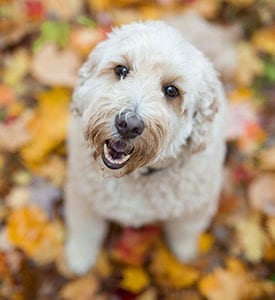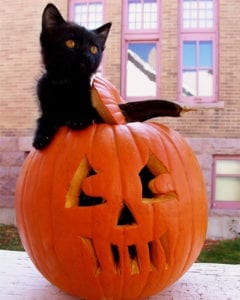Fall & Halloween Pet Safety Tips
Fall is a beautiful time of year up here in Connecticut, but there are plenty of risks that come with the season. Additionally, Halloween brings us a lot of excitement, fun, and some scares, too! Use our animal hospital’s Halloween pet safety tips below as a guide to help you and your pet avoid fall and Halloween-related hazards.
Falling Temperatures
It’s getting cold out there, and despite their fur coat, your pet can feel it, too. Shorten your pet’s time out in the yard and never leave them outdoors overnight unless they have a dry, warm shelter to curl up in. You should also consider getting a warm jacket for your pet, especially if their coat is short and/or made of finer hair. Also, their paw pads are vulnerable to the cold, so booties might not be a bad idea, either. While your pet may look a little silly in their cold-weather wear, it can make a big difference on long walks.
Poisonous Fungus
There are many different types of wild mushrooms that can usually be found in and around undergrowth where the soil is cool and damp. Death cap mushrooms, one of the deadliest (especially for dogs), often grow under pine trees, oaks, and other trees. Brownish-red lawn mushrooms are also life-threatening if eaten. Check your lawn for these, and if you take your pet for a walk in the woods, keep a very close eye on them and don’t allow them to go near any mushrooms.
For more information about poisonous mushrooms and what to do if you believe your pet has consumed one, contact the Pet Poison Helpline at (855) 764-7661.
Lingering Parasites
Despite their small size, pet parasites are tough and can survive harsh weather. While there might be a tinge of winter in the air, there is a good chance that fleas and ticks are still lurking around. For the best protection, your pet should receive monthly doses of parasite preventative all year round. Let us know if you need to stock up!
Health and Security
With the summer heat now just a memory, you look forward to taking your pet on long walks and visits to the dog park. But before you do, check that your pet is updated on all of their vaccines. We also recommend microchipping your pet so they have permanent identification in case they slip out of their harness and get lost. Microchipped pets have a greater chance of being returned to their families after they go missing.
Keep the Candy to Yourself
For once, it’s a good idea not to share! Many Halloween candies are toxic to pets, particularly those that contain chocolate and/or xylitol, an artificial sweetener. Both of these ingredients can cause some serious reactions, so keep candy well out of paw’s reach.
Limit the Scares
Your pet can be easily frightened this season due to all the costumers, scary noises, and eerie decorations. Costumes make you and your human family difficult for your pet to recognize you, which means they could run and hide or become aggressive. Also, noises like Halloween recordings and a constantly ringing doorbell can really stress a pet out. Make sure to play any recordings outdoors and sit outside, if possible, to keep the doorbell from ringing. Finally, always supervise your pet around decorations and keep harmful décor like lit candles and jack-o’-lanterns well out of paws’ reach.
Safety First with Pet Costumes
Some pets love to be dressed up—others do not. Try your pet’s costume on them a few days before Halloween to see how they like it. Make sure it fits them properly and doesn’t restrict their breathing, movement, eyesight, or hearing. If they seem content in it, you’re good to go. However, if they are obviously uncomfortable and stressed, it may be best to stick to a festive bandana instead!



